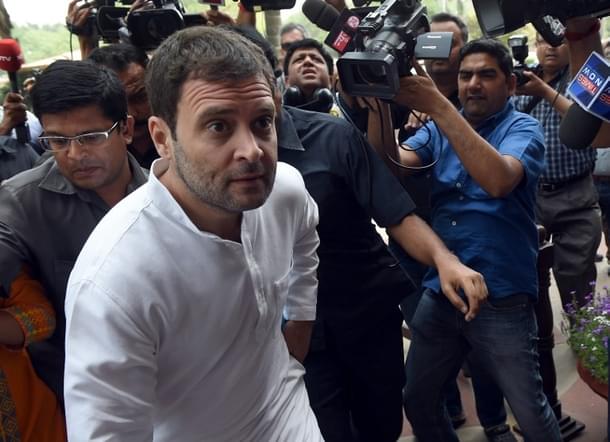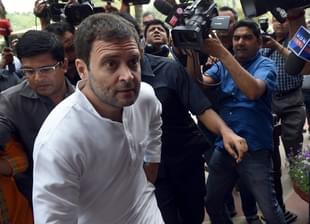Politics
Dynasty Blues
N V Subramanian
Apr 27, 2015, 07:04 PM | Updated Feb 24, 2016, 04:33 PM IST
Save & read from anywhere!
Bookmark stories for easy access on any device or the Swarajya app.


Existential concerns confront senior Congress leaders as Rahul Gandhi’s leadership of the party looms ahead.
When Salman Khurshid played Saif Ali Khan’s character in the short-video remake of the hit movie, Kal Ho Na Ho, for the German Embassy in India, he couldn’t be thought to be reflecting the anxiety of the Indian National Congress (INC) at the imminence of Rahul Gandhi’s leadership of the 130-year-old party. But art, even kitsch, could be imitating life in this case.
Senior leaders of the INC are struck with gloom and despair as Sonia Gandhi determinedly pushes Rahul to lead the party in the hope of better prospects in the 2019 general election. None of them are excited by the prospect of a Congress led by Rahul even as the national media fawns on him in inverse proportion. Increasingly, comparisons and contrasts are being made between the leadership styles of Sonia Gandhi and her son, to Rahul’s abiding disadvantage and burden. If there is any possibility that the Indian National Congress could do worse than now with a negligible tally of 44 Lok Sabha seats, it is almost universally accepted among senior INC leaders that Rahul Gandhi can effortlessly march the party down that doomed path.
Generational changes are usually resisted in all institutions, especially if they happen to have Indian provenance and the INC is no different. When Jawaharlal Nehru plotted for Indira Gandhi to succeed him, he was circumscribed by a weak hand after the 1962 debacle with state satraps like Y. B. Chavan becoming powerful. An interim prime ministry of someone like Lal Bahadur Shashtri was unavoidable in the circumstances. But Nehru knew enough of his daughter to believe she would prevail. She did so, following Shashtri’s sudden death, and overcame the reductive tag of goongi-gudia(dumb doll) by ruthlessly moving against the party old guard.
Learning from her own struggles of the necessity of planned and formalised succession, Indira Gandhi groomed Sanjay and following his airplane mishap, Rajiv. The Indian National Congress after successive splits was firmly and immutably dynastic in character but being cynical, suspicious and calculating, Indira Gandhi would take no chances. But as the poet said, the best-laid plans of mice and men often go awry.
In the intervening hours after her assassination and ahead of Rajiv Gandhi’s takeover, there was an attempt by Pranab Mukherjee and co. to commandeer the Congress boat. Still nettled by memories of the experience weeks after seizing power, Rajiv Gandhi railed against “power-brokers”. Old foxes like R. K. Dhawan were put on notice. But Rajiv Gandhi was soon in the grip of the dark forces he promised to combat, a fate that possibly awaits Rahul, and went into decline and fall within two years of winning India’s greatest Lok Sabha mandate.
The script changed thereafter, compelled as much by two political assassinations in one family within a decade as by the onset of the coalition era in Indian politics which heralded the rise of the other backward classes (OBCs).
The third factor of this change was Sonia Gandhi’s own reluctance to become prime minister in 2004 for reasons known to her. In choosing to become the power behind the throne for the two United Progressive Alliance (UPA) regimes she crafted and managed for 10 years, she arguably played her best hand. While she must be held morally to account for the loot and mega scams of the 10 UPA years between 2004-14, it is equally incontestable that she brought a measure of stability to that regime, however ineffective an instrument it remained to advance India’s growth, prosperity and development.

Even this small quality of stability would desert the party should Rahul Gandhi take full control of the Indian National Congress. Knowing this, nearly none of the wiseacres of the party see any prospect of Rahul Gandhi in public office; instead, they dread the INC’s most immediate fate and future under his leadership.
Unlike Sonia Gandhi who follows a strict regime of 9 to 5 office work at 10 Janpath, Rahul Gandhi is flighty. No sooner was he back from his 59-day, self-approved sabbatical from unknown destinations than he was trekking to Kedarnath in full view of news television crews and now plans a 1000-kilometre padyatra against the land acquisition bill. Such energetic activism has a place and time and cannot substitute the unromantic drudgery of painstaking organisational work so critical to sustain a mass party like the Indian National Congress tottering on its last legs. News television, eventually bored of its overexposed subjects, and being feral periodically, lapses to its past wildness and waywardness with a fierce snarl and bite.
Sonia Gandhi contrastingly understands the value of mystique and has exercised a sort of mesmerism over the INC which keeps sundry ambitions of multiple leaders in flower without posing any threat to the Nehru-Gandhis.
By stepping back from office, she has insulated herself to a degree from the failures of the Indian National Congress; but this cushion and comfort seem unavailable to Rahul Gandhi. Sonia Gandhi had the advantage of the wisdom of the likes of Pranab Mukherjee despite their fraught particular relations. Rahul Gandhi’s aides and advisors, though, defy any conventional political description while veering in the direction of the strange and the diabolical.
Digvijay Singh for a time was Rahul’s advisor, especially during the disastrous assembly election outings of Bihar and Uttar Pradesh in 2010 and 2012 respectively. Digvijay Singh is known in party circles by the initials DVS which tell their own story. With the further rapid decline of the INC foreseen with Rahul Gandhi’s impending leadership of the party, Salman Khurshid might be well-advised to make the full and final switch to Bollywood. As they say in the films, “Kal Ho Na Ho”.
N.V.Subramanian is the Editor of www.newsinsight.net and writes on politics and strategic affairs.





